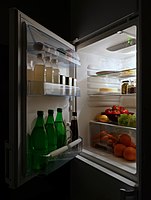
Photo from wikipedia
Abstract This study is pioneered in developing digital twins using Feed-forward Neural Network (FFNN) and multi objective evolutionary optimization (MOEO) using Genetic Algorithm (GA) for a counter-flow Dew Point Cooler… Click to show full abstract
Abstract This study is pioneered in developing digital twins using Feed-forward Neural Network (FFNN) and multi objective evolutionary optimization (MOEO) using Genetic Algorithm (GA) for a counter-flow Dew Point Cooler with a novel Guideless Irregular Heat and Mass Exchanger (GIDPC). The digital twins, takes the intake air characteristics, i.e., temperature, relative humidity as well as main operating and design parameters, i.e., intake air velocity, working air fraction, height of HMX, channel gap, and number of layers as the inputs. GIDPC’s cooling capacity, coefficient of performance (COP), dew point efficiency, wet-bulb efficiency, supply air temperature and surface area of the layers are selected as outputs. The optimum values of aforementioned operating and design parameters are identified by the MOEO to maximise the cooling capacity, COP, wet-bulb efficiencies and to minimise the surface area of the layers in four identified climates within Koppen-Geiger climate classification, namely: tropical rainforest, arid, Mediterranean hot summer and hot summer continental climates. The system monthly and annual performances in the identified optimum conditions are compared with the base system and the results show the annual improvements of up to 72.75% in COP and 23.57% in surface area. In addition, the annual power consumption is reduced by up to 49.41% when the system is designed and operated optimally. It is concluded that identifying the optimum conditions for the GIDPC can increase the system performance substantially.
Journal Title: Energy Conversion and Management
Year Published: 2020
Link to full text (if available)
Share on Social Media: Sign Up to like & get
recommendations!